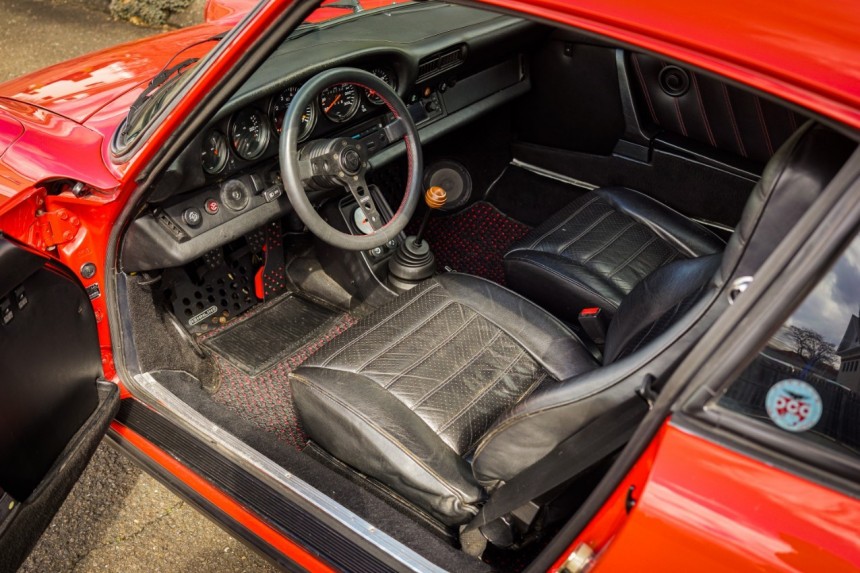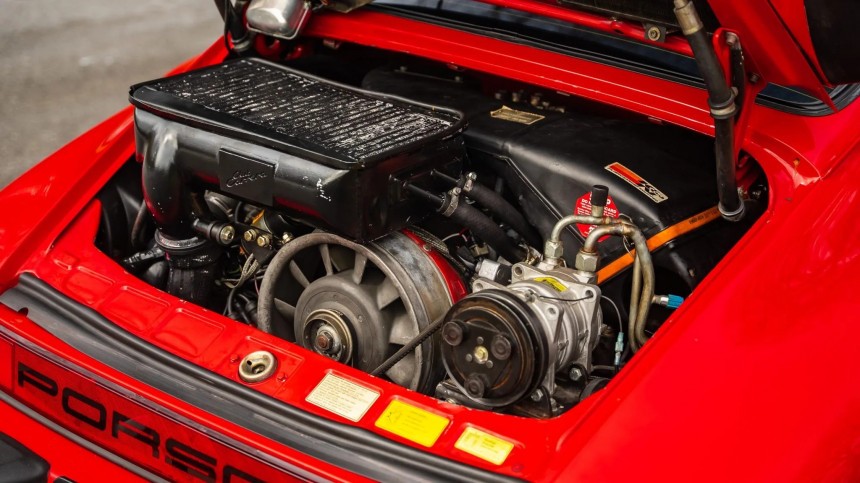Fundamentally, cars are a utility, getting you from point A to point B. Then, there are enthusiast cars, which take your transportation and make it enjoyable. But, among this list of enthusiast cars, there are some wicked creations, cars so scary, so dangerous, that they terrify even the bravest souls out there. These cars have claimed countless lives, yet, we still like them, and one of the prime examples of this lunacy is the Porsche 930 Turbo.
The 930 story starts with the creation of the 'souped-up' Beetle - the Porsche 911. Leaving the Beetle jokes aside, the 911 was born in 1964 as a bigger and more powerful replacement for the Porsche 356.
The 911 was an instant success, and Porsche went on to improve and make it faster and faster. This mentality gave birth to some pretty crazy machines, with this insanity peaking in the '70s. As in every great story, this turbocharged monster was born thanks to racing.
In the 1960s, Porsche was racing in Le Mans and doing an excellent job at it, using the flat-12 powered 917. By 1972, Porsche demolished everyone in racing, not just Le Mans. This thirst for winning landed them in the Can-Am championship, and that car was a really, really crazy beast.
The 917/10, or the 'Turbopanzer', as it was called, was based on the regular 917, but the Turbopanzer produced a ridiculous 1,100 hp (1,115 ps), which made it a challenge to drive, to say the least. But, at the hands of the daredevil George Follmer, the 917/10 took the win, ruining Can-Am forever, and I mean that literally - the Can-Am association banned the car from racing and then stopped running the race altogether.
The cancelation was terrible news for Porsche, as their turbocharged dreams weren't over. To fill the turbo-shaped hole left in their heart by Can-Am, Porsche found their place in the Grand Touring Championship in Group 4. But that was a problem because Group 4 required homologation, meaning these go-fast machines had to be sold to an unsuspecting public.
But, to race in the GT Championship, Porsche, first and foremost, needed to create the car. They took the 911, which was already a sports car tuned to perfection, and set about to make it fast. The mental engineers took the 3.0-liter (183 ci) engine from the Carrera RS and slapped a turbocharger on it to achieve the desired power. This action created the 930 Turbo and brought some consequences with it, and deadly ones at that.
Now, it's time to get into the knucks and crannies of this beast. We have a nice example from 1979 to analyze and see what makes it so crazy, yet so good, so let's dive deeper.
This particular car is finished in Guards Red, but no matter the color, the outside treatment was the same. All that power, which we'll get to in a minute, proved too much for the 911 chassis. To balance that, Porsche tried everything to try and tame it, but that wasn't enough. Alongside the mechanical changes, the body received a new engine cover with a massive wing and wider fenders to accommodate bigger rubber.
Speaking of the bigger rubber, it is wrapped around 16-inch Fuchs alloy wheels. Behind these wheels lay those modifications I mentioned before: a stiffer suspension and bigger brakes than your standard, run-of-the-mill 911. They did everything they could to try and control it, but nothing was enough.
Moving on to the inside, or where you'll cling on for dear life if you are brave enough to drive it. Step inside this rocket ship and black leather seats with matching dashboard and door panels greet you. Even though this is a serious performance car and an old one at that, it still has comfort amenities, like power windows and air conditioning.
Upon sitting in the death seat, a Momo Prototipo steering wheel will sit in front of you, behind which a 300 kph (186mph) speedometer and a tachometer with a 6,700 rpm redline are waiting to be pinned.
Now, it's time to get to the powerplant, which makes this car such a handful. When it came out in 1975, the 930 Turbo featured a 3.0-liter (183 ci) turbocharged flat-six engine, producing 260 hp (264 ps). Later, in 1978, the displacement was increased to 3.3 liters (201 ci), and the power went up to 300 hp (304 ps) - the one this car has.
That figure, at first glance, may not seem like that much, at least not enough to give the 930 the 'Widowmaker' moniker. But you have to remember that this is raw horsepower, and even more, it is in an old-school package. That means that the boost hits late, it hits hard, and you don't feel it coming.
To add fuel to the fire, if the full force of the turbo hits mid-corner, you are in a whole lot of trouble. You see, the 930’s engine sits far back over the rear axle, effectively acting like a slingshot. You had to plant your foot on the gas to countersteer it, which is pretty counter-intuitive.
If that doesn't sound scary enough for you, the Turbo we are talking about today has had some work done to the engine. It has an aftermarket Mille Miglia exhaust, a Fabspeed wastegate pipe, and a different turbocharger. Taking all of that into consideration, the power output might have gone up, but we can’t be sure, as a power figure wasn’t disclosed.
All of that oomph goes to the rear wheels through a four-speed transaxle manual transmission. That may seem a little old-fashioned, but the four-speed was much stronger than the flimsy but more modern five-speed box.
If you fancy yourself a deadly machine, this particular 930 is up at auction in New Canaan, Connecticut. The price is currently at 92,000 dollars and the mileage is displayed to be at 86,000 kilometers (53,000 miles). But the instrument panel was repaired in April of last year, so the exact mileage is unknown. The car also comes with service records beginning with 1994, a rebuilt engine, a clean New Jersey title, and a death wish, so drive at your own risk.
The 911 was an instant success, and Porsche went on to improve and make it faster and faster. This mentality gave birth to some pretty crazy machines, with this insanity peaking in the '70s. As in every great story, this turbocharged monster was born thanks to racing.
In the 1960s, Porsche was racing in Le Mans and doing an excellent job at it, using the flat-12 powered 917. By 1972, Porsche demolished everyone in racing, not just Le Mans. This thirst for winning landed them in the Can-Am championship, and that car was a really, really crazy beast.
The cancelation was terrible news for Porsche, as their turbocharged dreams weren't over. To fill the turbo-shaped hole left in their heart by Can-Am, Porsche found their place in the Grand Touring Championship in Group 4. But that was a problem because Group 4 required homologation, meaning these go-fast machines had to be sold to an unsuspecting public.
But, to race in the GT Championship, Porsche, first and foremost, needed to create the car. They took the 911, which was already a sports car tuned to perfection, and set about to make it fast. The mental engineers took the 3.0-liter (183 ci) engine from the Carrera RS and slapped a turbocharger on it to achieve the desired power. This action created the 930 Turbo and brought some consequences with it, and deadly ones at that.
This particular car is finished in Guards Red, but no matter the color, the outside treatment was the same. All that power, which we'll get to in a minute, proved too much for the 911 chassis. To balance that, Porsche tried everything to try and tame it, but that wasn't enough. Alongside the mechanical changes, the body received a new engine cover with a massive wing and wider fenders to accommodate bigger rubber.
Speaking of the bigger rubber, it is wrapped around 16-inch Fuchs alloy wheels. Behind these wheels lay those modifications I mentioned before: a stiffer suspension and bigger brakes than your standard, run-of-the-mill 911. They did everything they could to try and control it, but nothing was enough.
Upon sitting in the death seat, a Momo Prototipo steering wheel will sit in front of you, behind which a 300 kph (186mph) speedometer and a tachometer with a 6,700 rpm redline are waiting to be pinned.
Now, it's time to get to the powerplant, which makes this car such a handful. When it came out in 1975, the 930 Turbo featured a 3.0-liter (183 ci) turbocharged flat-six engine, producing 260 hp (264 ps). Later, in 1978, the displacement was increased to 3.3 liters (201 ci), and the power went up to 300 hp (304 ps) - the one this car has.
That figure, at first glance, may not seem like that much, at least not enough to give the 930 the 'Widowmaker' moniker. But you have to remember that this is raw horsepower, and even more, it is in an old-school package. That means that the boost hits late, it hits hard, and you don't feel it coming.
To add fuel to the fire, if the full force of the turbo hits mid-corner, you are in a whole lot of trouble. You see, the 930’s engine sits far back over the rear axle, effectively acting like a slingshot. You had to plant your foot on the gas to countersteer it, which is pretty counter-intuitive.
All of that oomph goes to the rear wheels through a four-speed transaxle manual transmission. That may seem a little old-fashioned, but the four-speed was much stronger than the flimsy but more modern five-speed box.
If you fancy yourself a deadly machine, this particular 930 is up at auction in New Canaan, Connecticut. The price is currently at 92,000 dollars and the mileage is displayed to be at 86,000 kilometers (53,000 miles). But the instrument panel was repaired in April of last year, so the exact mileage is unknown. The car also comes with service records beginning with 1994, a rebuilt engine, a clean New Jersey title, and a death wish, so drive at your own risk.
















